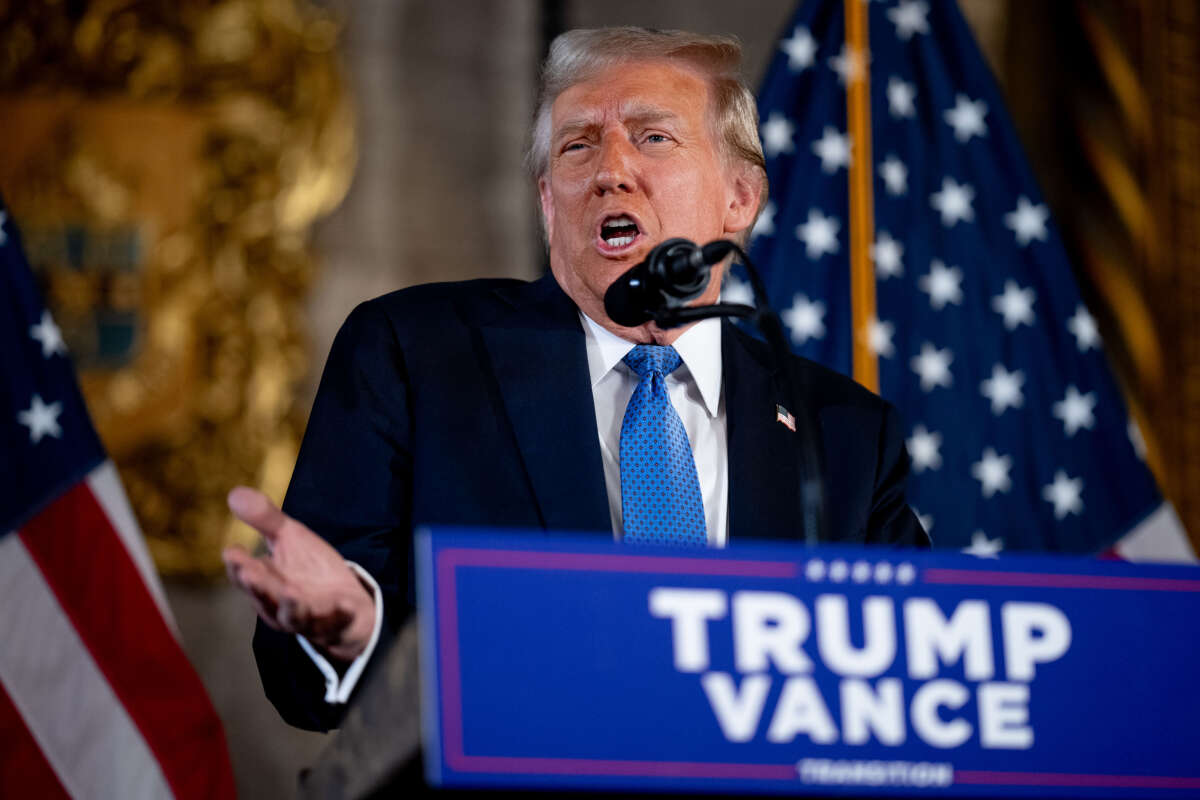This past weekend, President-elect Donald Trump suggested that his administration would seek to reclaim parts of Panama and wrest control of the entirety of Greenland.
During a Sunday rally in Arizona, Trump said that his administration would seek to regain control of the Panama Canal, wrongly claiming that the U.S. had “given” the canal to Panama, despite the fact that Panama’s control over the canal had been negotiated in a 50-year-old treaty.
“Has anyone ever heard of the Panama Canal? Because we’re being ripped off at the Panama Canal like we’re being ripped off everywhere else,” Trump said, adding that fees for ships to go through the canal “are ridiculous, highly unfair.”
The Panama Canal was created as an act of U.S. imperialism during the administration of President Theodore Roosevelt. After its construction in the early 1900s, the U.S. maintained political control of the “Canal Zone” in Panama until 1977, when a treaty between the two countries granted both equal control of the zone until 1999, when Panama took sole control over it. The treaty stipulated that Panama must remain neutral regarding who it allows to pass through the canal.
Fees have indeed risen in Panama in recent years. But although there’s no evidence that rising fees are directed at ships coming from the U.S. versus elsewhere, Trump baselessly suggested that Panama was ignoring the neutrality agreement due to Chinese influence.
“If the principles, both moral and legal, of this magnanimous gesture of giving are not followed, then we will demand that the Panama Canal be returned to us, in full, quickly and without question,” Trump said.
Panama President Jose Raul Mulino objected to Trump’s comments, resolutely stating that the Canal Zone would not be returned to the U.S.
“Every square meter of the Panama Canal and the surrounding area belongs to Panama and will continue belonging (to Panama),” Mulino said.
Trump’s imperialist sentiments on Sunday didn’t stop there — that same afternoon, the president-elect reiterated his insistence that the island of Greenland (which is officially under the realm of the Kingdom of Denmark, but has its own independent government) should be under the rule of the United States instead.
“For purposes of National Security and Freedom throughout the World, the United States of America feels that the ownership and control of Greenland is an absolute necessity,” Trump said in the announcement of his pick for ambassador to Denmark.
During his first term as president, Trump similarly expressed a desire for the U.S. to purchase Greenland, and also reportedly said that he wanted to trade Puerto Rico for Greenland. Although his staff later claimed that comment was a joke, a former aide to Trump said it was real and based on racist attitudes of the then-president.
“He actually said he wanted to see if we could sell Puerto Rico — could we swap Puerto Rico for Greenland because, in his words, Puerto Rico was ‘dirty’ and ‘the people were poor,'” former Department of Homeland Security (DHS) chief of staff Miles Taylor said in 2020.
Trump likely wants to purchase Greenland because he senses an economic opportunity there — one that would cause great environmental harm to the region. The melting of glacial ice on the island, due to the effects of the climate crisis, could open up the land to mining projects that large corporations can exploit, especially if Trump has control over approving those projects. Notably, Greenland is a largely autonomous and majority-Inuit country.
Greenland Prime Minister Múte Egede shot down Trump’s colonialist statements in comments on Monday.
“Greenland is ours. We are not for sale and will never be for sale,” Egede said. “We must not lose our long struggle for freedom.”
Angry, shocked, overwhelmed? Take action: Support independent media.
We’ve borne witness to a chaotic first few months in Trump’s presidency.
Over the last months, each executive order has delivered shock and bewilderment — a core part of a strategy to make the right-wing turn feel inevitable and overwhelming. But, as organizer Sandra Avalos implored us to remember in Truthout last November, “Together, we are more powerful than Trump.”
Indeed, the Trump administration is pushing through executive orders, but — as we’ve reported at Truthout — many are in legal limbo and face court challenges from unions and civil rights groups. Efforts to quash anti-racist teaching and DEI programs are stalled by education faculty, staff, and students refusing to comply. And communities across the country are coming together to raise the alarm on ICE raids, inform neighbors of their civil rights, and protect each other in moving shows of solidarity.
It will be a long fight ahead. And as nonprofit movement media, Truthout plans to be there documenting and uplifting resistance.
As we undertake this life-sustaining work, we appeal for your support. Please, if you find value in what we do, join our community of sustainers by making a monthly or one-time gift.
